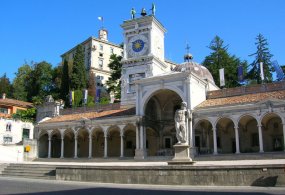 Hotel Rex
****
Hotel REX is a modern design boutique...
Viale delle Palme, 45 -
Pineta
Hotel Rex
****
Hotel REX is a modern design boutique...
Viale delle Palme, 45 -
Pineta
 Hotel Vittoria
****
Located in the eastern part of...
Lungomare Marin, 28 -
Sabbiadoro
Hotel Vittoria
****
Located in the eastern part of...
Lungomare Marin, 28 -
Sabbiadoro
 Park Hotel
****
Recently renovated, the Park Hotel,...
Viale delle Palme, 41 -
Pineta
Park Hotel
****
Recently renovated, the Park Hotel,...
Viale delle Palme, 41 -
Pineta
 Hotel Conca Verde
****
The Hotel Conca Verde, standing...
Via Carinzia, 28 -
Sabbiadoro
Hotel Conca Verde
****
The Hotel Conca Verde, standing...
Via Carinzia, 28 -
Sabbiadoro
 Hotel Helvetia
****
The hotel Helvetia, ideal for those...
Corso degli Alisei, 9 -
Pineta
Hotel Helvetia
****
The hotel Helvetia, ideal for those...
Corso degli Alisei, 9 -
Pineta

Region: Friuli-Venezia Giulia
Elevation: 113 m a.s.l.
Area: 56,81 km²
Population: 99.723 (as of February, 2011)
Time zone: CET, UTC+1
Gentilic: Udinesi
Patron: Sts. Ermacoras and Fortunatus
Patron-Day: July 12
Udine is chief town of the homonymous province and it is considered the today chief town of the region Friuli-Venezia Giulia.
The city is located at the centre of the region and it is, as the crow flies, about 20 km from Slovenia and about 54 km from Austria. This puts the city in a strategic position, at the intersection of East-West and North-South European lines, on the road to Austria and to the Eastern Europe.
It rises in the plains around a hill, on which it is located the castle, few kilometres from the hills and bordered by the river Cormor at West and river Torre at East.
Chief town of the historical region Friuli, inhabited from the Neolithic period, its importance grew thanks to the decline of Aquileia before and Cividale after. Named as Utinum in the occasion of the donation of the city castle by the Emperor Otto II in 983, in 1238 it became seat of the Patriarchate of Aquileia. Thanks to the Patriarch Bertoldo of Andechs, who moved from Cividale to Udine where was built the patriarchal palace, Udine became the most important city in the region for the commerce.
During the First World War Udine was, until the defeat of Caporetto, seat of the high Italian command, much to receive the title of "Capital of War".
One of the most suggestive places is sure the Castle of Udine, that stands on a hill and dominates the entire city. From immemorial time, was present on the hill a fortified site testified by the remains of Neolithic and Roman period found on the castle hill. After many changes, the castle was severely damaged by the earthquake of 1511. In 1517 begun the reconstruction, but it lasted long time, for lack of funds, vastness and complexity of the project. Today in the castle there are the Civic Museums that include an art gallery, the archaeological and numismatic museum, the Museum of Risorgimento and a photo library. The rooms of palace hosts often temporary exhibitions.
In the big garden-terrace on the top of the castle, there is the Casa della Contadinanza, in which lived the representatives of the farmers. The building has then hosted the armory of the castle and in recent times it has been used as place for tasting of typical products.
The domination of Venice appears in all its charm in Piazza della Libertà with the Loggia del Lionello, one of the meeting points of the inhabitants. The loggia is in Venetian Gothic style and it was, already at the time of Republic of Venice, enriched with many works of artists that succeed in the time. Now the most part of them are in the museum of the city.
In front of the Loggia del Lionello there are the Loggia and the Temple of San Giovanni, with many references to Brunelleschi. In the Loggia of San Giovanni is located the clock tower, built in 1527 on project of Giovanni da Udine, which was inspired by the tower of Piazza San Marco in Venice. On the top there are two Moors striking the hour on the bell, the today sculptures in copper have replaced the original in wood.
From Piazza della Libertà you can reach then the Castle of Udine through a climb, where you cross the Bollani Arch, surmounted by the lion of San Marco. You reach so the church of Santa Maria of Castle, the oldest in the city. Place against the church there is the House of Confraternity, medieval building renovated in 1930. Near, it stands the Grimani Arch, erected in 1522, through which you reach the forecourt of the castle.